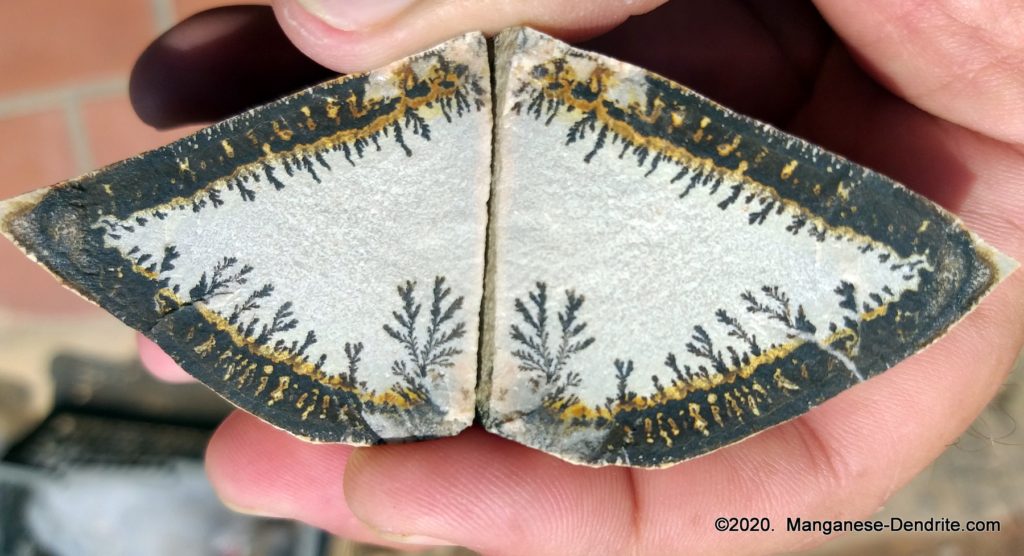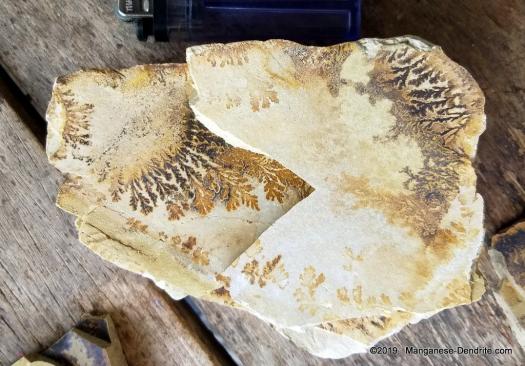Some Manganese Dendrites are better than others!
Some are worth as much as any rock you find on the ground.
Some are worth hundreds (or thousands) of Dollars.
Grading manganese dendrites is very subjective. But there are many factors you can use to grade a dendrite.
Shape, size, standablilty, rock color, feature color or colors, weight, clarity of picture or scene are all factors in grading dendrites.
The most important factor, if you’re buying, trading, or hunting for dendrites: Do you like it?

Grading is useful if you are buying or selling dendrites, but it is still very subjective.
Certain aspects, such as weight , shape and dimensions should be specified exactly. (or closely as far as shape and dimension). However, these aspects probably don’t affect the worth of the dendrite.
Other aspects, such as clarity, features, and scenes on the rock, are subjective. Of course, these are the factors that affect the value of a dendrite.
The grading scale for dendrites consists of
One grade for Single Dendrite. And a separate system for Doubles and Puzzles. A Double is 2 or more mirrored images from one rock. a puzzle can have a double but also broken pieces from the same rock.
Singles are broken down into first quality and second quality.
First Quality Rocks are broken down into first, second, and third grade, with first being the best of the best.
Second Quality Rocks are also broken down into first, second and third. Anything below a third is considered a throwaway.
Doubles and Puzzles are graded between 1 and 4, with 1 being the best. Below a 4 is a Throwaway or can be a Friendly.
From the International Association of Manganese Dendritologist. (IAMnD)

Here is a list of what criteria to look for in a Manganese Dendrite
- Size (general dimensions).
- Weight (in grams or kilograms).
- General shape of the Dendrite.
- How the dendrite stands on its own.
- Features of the picture or pictures on the Dendrite.
- Main feature of the Dendrite.
- How many sides of the Dendrite feature good pictures.
- Does the picture make a scene.
- Basic rock color (or colors on different sides, which can vary.)
- Colors of the features on the Dendrite.
- Mirroring – is it a double or triple or more.
- Breakability – can the rock be broken to get a better scene or mirror images inside.
- Is it a set of rocks – some dendrites are collected as sets. Usually similar pictures or scenes that come from the same larger dendrite.
None of these criteria above can really make a manganese dendrite more or less valuable, except for the main feature of the dendrite.
In general, the bigger the size of the main feature, and how many sides have very good features, all other factors remaining the same, make the dendrite more desirable. Weight is generally not a factor.
The shape, if unusual, can make a difference, but not always.
The number of sides with good quality pictures makes the dendrite more valuable.
Mirroring – when a dendrite is broken in half (or more), you can get mirror images of the scene.
If the dendrite can sit on a table with the main feature in the desired orientation and easily visible, this can usually make the dendrite more valuable.
The more sides showing, with good quality features makes the dendrite more valuable.
The colors of the rock and the features, if they are rare, can make a dendrite more valuable. Also, the more colors on a rock face can add value. Or not.
Breakablity – many dendrite rocks can be broken in half (or many pieces), and each side will mirror the other side. If you’re familiar with geodes, this is the general idea. However with Manganese Dendrites, the two sides should be mirror images of each other.

If you find a pictures of Jesus, or someone or something in a similar vein, your Manganese Dendrite can be priceless.

Form ID Number Rock Description ProcessingName Weight Cut?Description Dimensions Broken Number of Sides BreakablilityQuality Rating Number of Good Sides FragilePrice Offered General Shape Varnished Rock Color Single / Double / Multi How Many Pieces Special Rare Features Strange Main Feature Famous Other Features Side B Feature Color Date Entered Date Collected Collected By Date Sold Sold By Sold To Price Sold Current Location Lent To Lent for how many days Lending description |